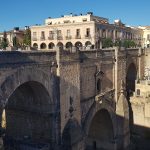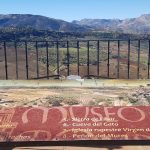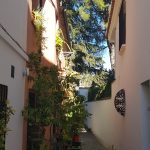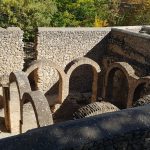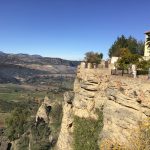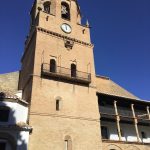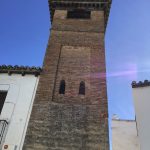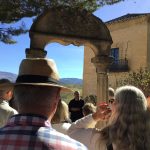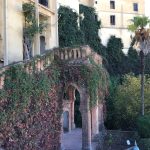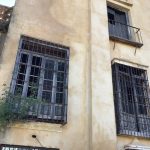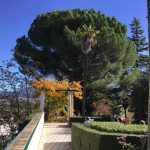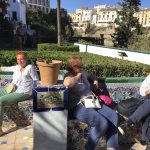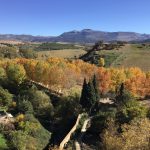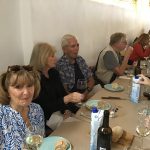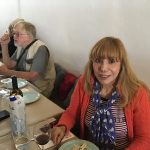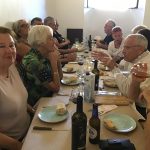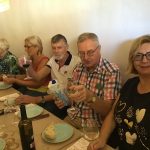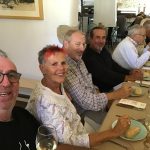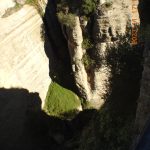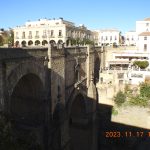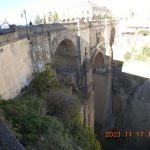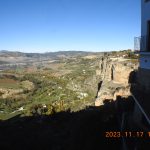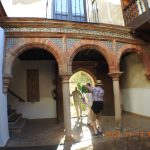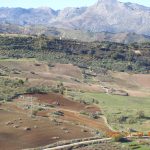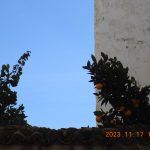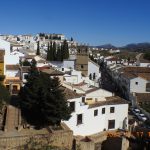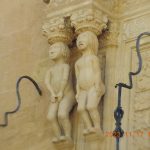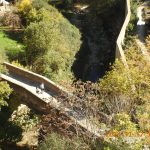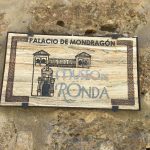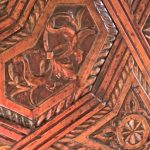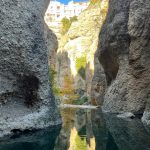After a wonderful presentation by Rafa Anderson about Ronda on Thursday 9th November, a group of us made a visit to Ronda on Friday 17th with Rafa.
The weather was good for our day out but our breakfast stop was a little further than usual in Ardales but then the last part of the journey to Ronda was shorter. I had contacted the traffic police to see if we could be dropped at the Parador instead of the bus station and this was agreed. It transpired that our driver, Miguel Angel also had a friend in the Ronda Police and so made a double check as he was concerned about getting a fine – all was well ! However, it seems that no matter what time of year one visits Ronda, there are always hoards of tourists, individuals and groups.
We stopped for a short while at the mirador on the Tajo (or New) bridge and then quickly escaped the crowds, down some narrow streets which opened up into a quiet square with stunning views of the countryside. Here, Rafa did some more explaining before we moved on to the Palacio de Mondragon which is now the Museum of Ronda. The Museum houses a range of architectural styles and artefacts. The gardens here are also pretty with great views. We then moved along through the lovely Plaza Duquesa, with a convent and the Ayuntamiento and continued on to the small Plaza Abdul Bakr, where there is a very tall former Minaret, now Christian bell tower. Abdul Bakr was a poet and whilst here, Rafa read us part of a beautiful poem by him
“The Lament of Al Andalus”
Everything that rises to a great height
Begins to decline
Don’t be seduced by the charms of life
What is human suffers revolution
If fortune smiles once
At another time it will afflict you
Where are the monarchs of Yemen
Where are their crowns and diadems
Kings and kingdoms are like shadows
That man sees dreaming
Begins to decline
Don’t be seduced by the charms of life
What is human suffers revolution
If fortune smiles once
At another time it will afflict you
Where are the monarchs of Yemen
Where are their crowns and diadems
Kings and kingdoms are like shadows
That man sees dreaming
During this stop, the house next door opened and a man stood on the balcony, looking down at us. As we started to move off, he opened his door at street level – it seems his house had been lived in by a senior clergy but was now a shop. It was quite extraordinary, very dusty, with a mix of ceramics and wooden objects. One of our group purchased a large ceramic bowl with a wonderful design.
We continued on, along more pretty cobbled streets, to the the Casa del Rey Moro and the Forrestier Gardens. This property is known as a bit of a fraud, having been built more recently at the beginning of the 20th C and the gardens designed by the landscape architect Forrestier, with an Islamic influence, built in 1912. However, there is the oldest water mine down more than 200 steps, which dates from the 14th C. Some of our group made the descent, others just relaxed in the gardens until we were all together for our descent to the Arab baths which are nearby. The stairs down are also cobbles and very slippery in places and also quite narrow where there is natural rock. However, the baths are interesting, there is a video which explains a lot and pretty gardens. By now, we were all ready to adjourn to the nearby Restaurant Clemente for lunch. We then had a short walk though more wonderful scenery, over an old bridge, to meet our driver. We arrived back in Nerja just after 19.00 – it had been a long but very worthwhile day.
With special thanks to Rafa Anderson for sharing his passion for and knowledge of Ronda with us.
Christina Sinclair
Co-ordinator
Nerja History Group
email:nerjahistorygroup@yahoo.com
www.nerjahistorygroup.com

